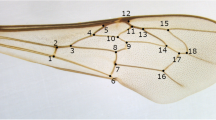Abstract
Non-lethal sampling of DNA from honeybees is commonly required for genotyping certain behavioural traits required for breeding. One method is to use wing clippings. However, the sample is very small, and the extraction process can be difficult, resulting in low polymerase chain reaction (PCR) amplification. Here, we describe an improved method for extracting DNA from bee wings using a commercially available kit that uses bashing beads to physically break up the wings. It enabled 93% to 100% PCR amplification when amplified using microsatellite or mitochondrial primers. The results were compared with the Chelex® 100 extraction method, which, in this laboratory, resulted in only between 56% and 72% amplification in subsequent PCR.

Similar content being viewed by others
References
Böttger, E.C. (1990) Frequent contamination of Taq polymerase with DNA. Clin. Chem. 36, 1258–1259
Bowen-Walker, P.L., Martin, S.J., Gunn, A. (1999) The transmission of deformed wing virus between honeybees (Apis mellifera L.) by the ectoparasitic mite Varroa jacobsoni Oud. J. Invertebr. Pathol. 73, 101–106
Châline, N., Ratnieks, F.L.W., Raine, N.E., Badcock, N.S., Burke, T. (2004) Non-lethal sampling of honey bee, Apis mellifera, DNA using wing tips. Apidologie 35, 311–318
Franck, P., Coussy, H., Le Conte, Y., Solignac, M., Gaernery, L., Corunet, J.-M. (1999) Microsatellite analysis of sperm admixture in honeybee. Insect Mol. Biol. 8, 419–421
Franck, P., Koeniger, N., Lahner, G., Crewe, R.M., Solignac, M. (2000) Evolution of extreme polyandry: an estimate of mating frequency in two African honeybee subspecies, Apis mellifera monticola and A. m. scutellata. Insectes soc 47, 364–370
Garedew, A., Schmolz, E., Lamprecht, I. (2004) The energy and nutritional demand of the parasitic life of the mite Varroa destructor. Apidologie 35, 419–430
Gregory, P.G., Rinderer, T.E. (2004) Non-destructive sources of DNA used to genotype honeybee (Apis mellifera) queens. Entomol. Exp. Appl. 111, 173–177
Griffiths S (1996) DNA by Chelex 100 extraction [online methods forum] http://www.bio.net/bionet/mm/methods/1996-November/052029.html (accessed 28 October 2010)
Harbo, J.R., Harris, J.W. (2005) Suppressed mite reproduction explained by the behaviour of adult bees. J. Apic. Res. 44, 21–23
Harris, J.W. (2008) Effect of brood type on Varroa-sensitive hygiene by worker honey bees (Hymenoptera: Apidae). Ann. Entomol. Soc. Am. 101, 1137–1144
Higes, M., Martín-Hernández, R., Botías, C., Baílon, E.G., González-Porto, A.V., Barrios, L., del Nozal, M.J., Bernal, J.L., Jiménez, J.J., Palencia, P.G., Meana, A. (2008) How natural infection by Nosema ceranae causes honeybee colony collapse. Environ. Microbiol. 10, 2659–2669
Pan, Y.-B., Burner, D.M., Ehrlich, K.C., Grisham, M.P., Wei, Q. (1997) Analysis of primer-derived, nonspecific amplification products in RAPD-PCR. Biotechniques 22, 1071–1077
Pérez-Sato, J.A., Châline, N., Martin, S.J., Hughes, W.O.H., Ratnieks, F.L.W. (2009) Multi-level selection for hygienic behaviour in honeybees. Heredity 102, 609–615
Solignac, M., Vautrin, D., Loisaeu, A., Mougel, F., Baudry, E., Estoup, A., Garnery, L., Haberl, M., Cornuet, J.-M. (2003) Five hundred and fifty microsatellite markers for the study of the honeybee (Apis mellifera L.) genome. Mol. Ecol. Notes 3, 307–311
Steffens, D.L., Roy, R. (1998) Sequence analysis of mitochondrial DNA hypervariable regions using infrared fluorescence detection. Biotechniques 24, 1044–1046
Su, S., Albert, S., Zhang, S., Maier, S., Chen, S., Du, H., Tautz, J. (2007) Non-destructive genotyping and genetic variation of fanning in a honey bee colony. J. Insect Physiol. 53, 411–417
Sušnik, S., Kozmus, P., Poklukar, J., Meglic, V. (2004) Molecular characterisation of indigenous Apis mellifera carnica in Slovenia. Apidologie 35, 623–636
Van Engelsdorp, D., Evans, J.D., Saegerman, C., Mullin, C., Haubruge, E., Nguyen, B.K., Frazier, M., Frazier, J., Cox-Foster, D., Chen, Y., Underwood, R., Tarpy, D.R., Pettis, J.S. (2009) Colony collapse disorder: a descriptive study. PLoS ONE 4, e6481
Walsh, P.S., Metzger, D.A., Higuschi, R. (1991) Chelex® 100 as a medium for simple extraction of DNA for PCR-based typing from forensic material. Biotechniques 10, 506–513
Acknowledgements
The authors thank Praveen Nair for his assistance in the laboratory. We also thank Janet Yu for letting us try the ZR bashing bead Bacterial/Fungal DNA extraction kit, which ultimately showed us how this extraction method was superior. The work was funded by Environment Canterbury (contract no. 24954) and the Sustainable Farming Fund (contract no. 24813, sustainable control of V. destructor).
Une méthode plus perfectionnée pour extraire et amplifier l'ADN provenant des ailes d'abeilles
ADN / aile d'abeille / PCR / Chelex® 100
Eine verbesserte Methode zur Extraktion und Amplifizierung von DNA aus Bienenflügeln
DNA / Bienenflügel / PCR / Mahlkugeln / Chelex® 100
Author information
Authors and Affiliations
Corresponding author
Additional information
Manuscript editor: Klaus Hartfelder
Rights and permissions
About this article
Cite this article
Gould, E.M., Taylor, M.A. & Holmes, S.J. A more consistent method for extracting and amplifying DNA from bee wings. Apidologie 42, 721–727 (2011). https://doi.org/10.1007/s13592-011-0077-x
Received:
Revised:
Accepted:
Published:
Issue Date:
DOI: https://doi.org/10.1007/s13592-011-0077-x




